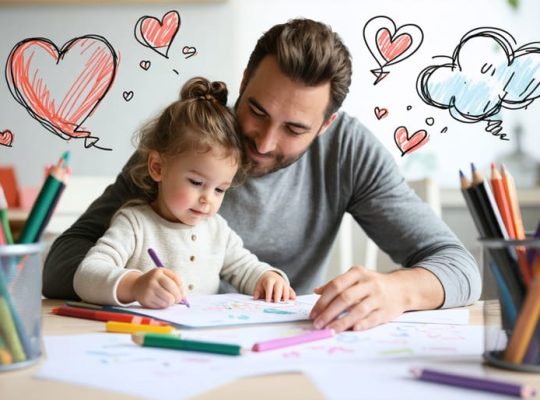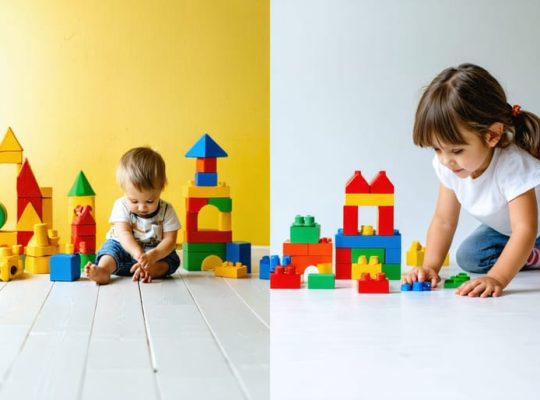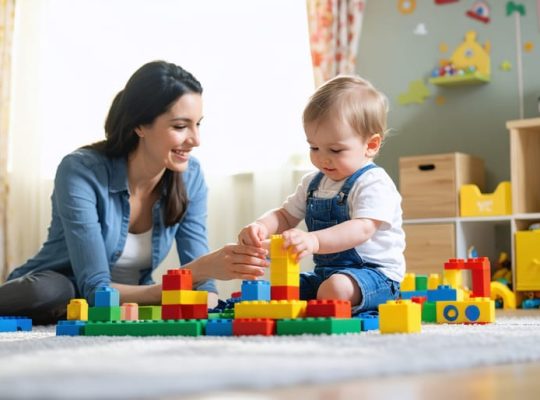Picture a kindergarten classroom filled with laughter, where children build towers from blocks, create imaginative stories with puppets, and solve problems through hands-on exploration. This is play-based learning at its finest – a powerful educational approach that nurtures both academic and social-emotional development.
Research consistently shows that children learn best when they’re actively engaged in meaningful play. Through carefully designed play experiences, children develop critical thinking skills, emotional resilience, and a natural curiosity about the world around them. They’re not just playing – they’re laying the foundation for lifelong learning.
What sets play-based kindergarten apart is its respect for children’s natural development. Rather than forcing structured academics too early, this approach recognizes that young minds thrive when allowed to explore, create, and problem-solve through play. Teachers act as skilled facilitators, enriching play experiences with intentional learning opportunities while following the children’s interests and developmental needs.
For parents and educators alike, understanding play-based kindergarten means recognizing that those moments of seemingly simple play – whether building with blocks or engaging in dramatic play – are actually powerful opportunities for learning, growth, and meaningful connection.
Why Play Matters in Early Education
The Science Behind Play and Bonding
When children engage in play, their brains release feel-good chemicals like oxytocin and dopamine, creating positive associations with both the activity and the people involved. These natural chemical responses help to strengthen attachment between children and their caregivers, making play time a powerful tool for emotional bonding.
Dr. Sarah Chen, a child development specialist, explains: “During play, children feel safe to express themselves and connect with others. This emotional security creates lasting neural pathways that support healthy relationship development.”
Through activities like pretend play, building blocks, or simple games, children learn to read social cues, develop trust, and form secure emotional connections. The back-and-forth interactions during play mirror the serve-and-return pattern that’s essential for healthy brain development in early childhood.
When adults fully engage in play with children, making eye contact, showing genuine interest, and responding warmly to their initiatives, they create moments of connection that build the foundation for lifelong emotional well-being and learning readiness.
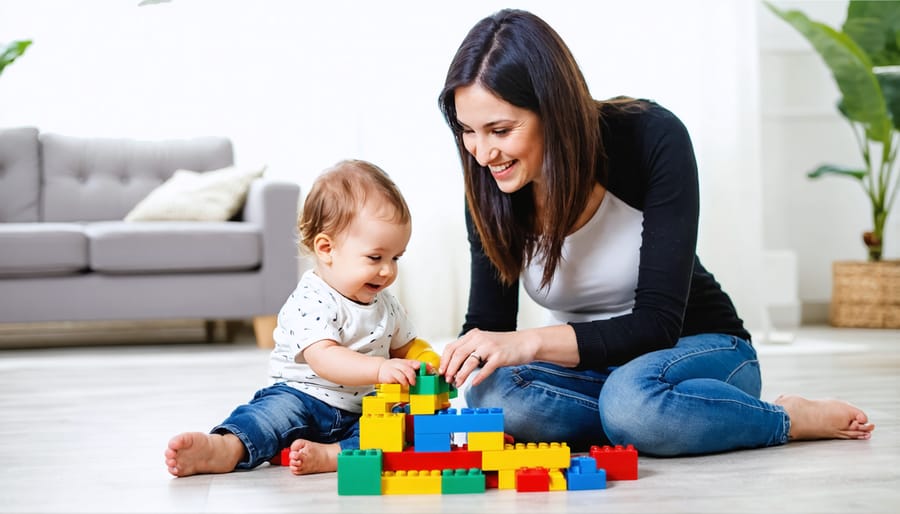
Social-Emotional Benefits
Play-based kindergarten provides a nurturing environment where children develop crucial emotional intelligence and social skills naturally. Through collaborative play, children learn to share, take turns, and resolve conflicts independently. These early experiences help them understand and manage their emotions while developing empathy for others.
Dr. Sarah Thompson, a child psychologist, notes that when children engage in imaginative play with peers, they practice essential life skills like negotiation, cooperation, and leadership. Whether they’re working together to build a block tower or playing house, these interactions teach them how to communicate effectively and respect different perspectives.
Play-based learning also creates a safe space for children to express their feelings and work through challenging emotions. When children act out scenarios through dramatic play, they develop coping strategies and build resilience. This emotional growth is particularly valuable during the transition to formal schooling.
Parents often report seeing positive changes in their children’s ability to form friendships, show compassion, and regulate their emotions after attending play-based kindergarten programs. These social-emotional skills form the foundation for lifelong relationships and emotional well-being.
Creating Meaningful Play Experiences at Home
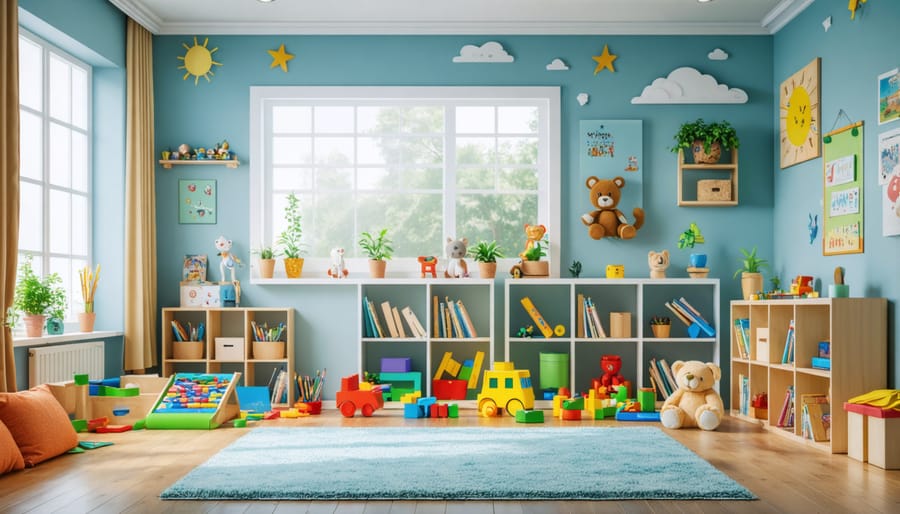
Setting Up Your Play Space
Creating an inviting play space is essential for successful play-based learning in kindergarten. Start by designating clear activity zones that allow children to move freely between different types of play. Consider including a cozy reading corner with soft cushions and age-appropriate books, a building area with blocks and construction materials, and an artistic space with easels and craft supplies.
Ensure materials are stored at child height in clear, labeled containers to promote independence and organization. This helps children learn responsibility while making cleanup time more manageable. Rotate toys and materials regularly to maintain interest and create new learning opportunities.
Natural light and comfortable temperatures help children stay focused and engaged. Include elements from nature, such as plants or a small sensory table with sand and water, to connect children with the natural world. Consider using neutral colors for the main space while adding pops of color through educational materials and children’s artwork.
Safety is paramount, so regularly check for potential hazards and ensure all materials are age-appropriate. Create enough open floor space for group activities and movement-based play. Consider incorporating flexible seating options like floor cushions, small chairs, and standing tables to accommodate different learning styles and preferences.
Remember to include a quiet space where children can retreat when feeling overwhelmed. This helps develop emotional regulation skills while respecting individual needs for downtime during busy play periods.
Choosing the Right Activities
Selecting the right activities for play-based learning doesn’t have to be complicated. The key is to follow your child’s natural interests while introducing activities that support their development. Building blocks and construction toys are excellent for developing spatial awareness and problem-solving skills, while dramatic play with dolls or puppets helps children understand emotions and social relationships.
Art activities like drawing, painting, and clay modeling allow children to express themselves creatively while developing fine motor skills. Simple science experiments, like watching seeds grow or exploring water play, spark curiosity and introduce basic scientific concepts naturally.
Remember to rotate activities to maintain interest and include both quiet and active play. Music and movement activities, such as dancing or playing simple instruments, help develop coordination and rhythm while making learning fun. Outdoor play, including nature walks or sandbox activities, provides opportunities for physical development and environmental awareness.
Let your child take the lead sometimes – their natural curiosity will guide them toward activities that interest them most. When children are engaged in activities they enjoy, learning happens naturally. Keep sessions short (15-20 minutes) and be ready to switch activities if your child loses interest.
For the best results, join in the play yourself. Your participation not only makes the activity more enjoyable but also strengthens your bond with your child while modeling learning behaviors.
Incorporating Learning Through Play
Literacy and Language Play
In play-based kindergarten, literacy and language development happens naturally through engaging activities that make learning fun and meaningful. Children explore letters, sounds, and words through interactive storytelling sessions, where they act out characters and create their own narrative twists. This dramatic play helps develop vocabulary, comprehension, and verbal expression skills.
Teachers incorporate rhyming games, songs, and finger plays that help children recognize sound patterns and develop phonological awareness. Simple activities like setting up a pretend restaurant where children “write” menus and take orders, or creating a classroom post office where they exchange written messages, make literacy learning authentic and enjoyable.
During free play, children often gravitate toward literacy-rich areas featuring comfortable reading nooks with picture books, puppet theaters, and writing centers stocked with various materials. These spaces encourage spontaneous storytelling, early writing attempts, and peer-to-peer communication.
Language development is further enhanced through social play, where children negotiate roles, share ideas, and solve problems together. Teachers support these interactions by asking open-ended questions, expanding on children’s responses, and modeling rich vocabulary in context.
Regular show-and-tell sessions give children opportunities to practice public speaking and listening skills while sharing their interests with classmates. This combination of structured and unstructured language activities creates a rich environment where literacy skills develop naturally through play.
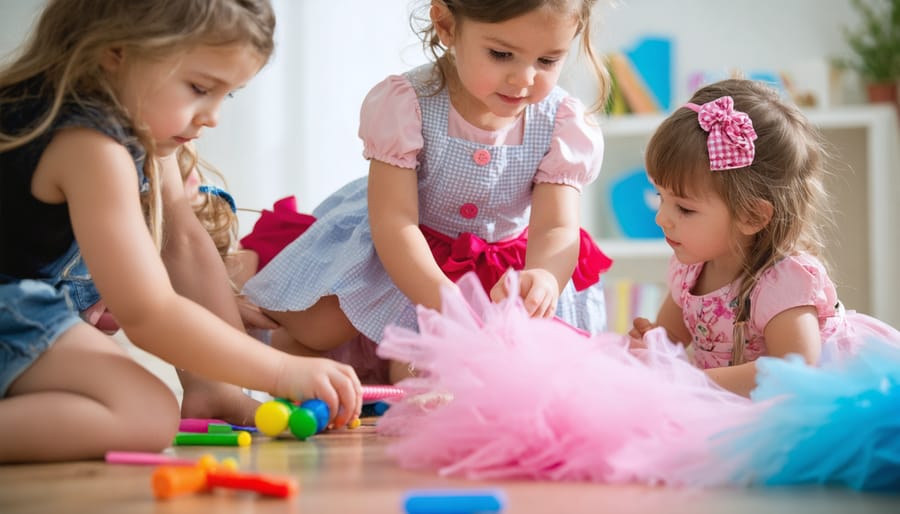
Problem-Solving Through Play
Through carefully selected games and activities, play-based kindergartens create opportunities for children to develop critical thinking skills naturally. Building block challenges encourage spatial reasoning and problem-solving as children figure out how to create stable structures. When teachers ask open-ended questions like “What else could we try?” or “How might we make it taller?”, they’re fostering creative solutions.
Board games and puzzles provide excellent opportunities for developing strategic thinking while building social skills. As children play together, they learn to take turns, negotiate rules, and work through conflicts – all vital life skills that strengthen peer relationships.
Simple science experiments, like testing which objects float or sink, turn curiosity into scientific inquiry. When children make predictions and test their theories through hands-on play, they’re developing the foundations of scientific thinking while having fun.
Dramatic play scenarios, such as running a pretend restaurant or hospital, allow children to practice real-world problem-solving. They must figure out how to organize roles, manage resources, and adapt their play as new challenges arise. Teachers can enrich these experiences by joining in and modeling problem-solving language.
Art projects also present natural opportunities for critical thinking. When a child runs out of blue paint, they must experiment with color mixing or find creative alternatives. These moments of challenge during play help build resilience and flexible thinking while keeping children engaged and motivated to learn.
Supporting Emotional Connection
Active Listening During Play
Active listening during playtime goes beyond simply watching children play – it’s about being fully present and engaged in their world. When children are playing, get down to their eye level and observe their actions, expressions, and the stories they’re creating. Show genuine interest by asking open-ended questions like “What’s happening in your story?” or “How did you decide to build that?”
Remember to validate their ideas and emotions with encouraging responses such as “I see how carefully you’re stacking those blocks” or “You seem really excited about this game.” This kind of attentive engagement helps children feel heard and valued.
Try to avoid interrupting their play flow with too many questions or directions. Instead, wait for natural pauses to comment or join in. When children invite you to participate, follow their lead and let them direct the play scenario. This approach builds their confidence and strengthens your connection with them.
Pay attention to non-verbal cues too – a child’s body language and facial expressions often tell us more than their words. Through active listening during play, you create a safe space for children to express themselves freely and develop their creativity.
Managing Challenges
While play-based kindergarten offers numerous benefits, it’s natural to encounter some challenges along the way. One common concern is maintaining structure while allowing for free play. Teachers can address this by establishing clear routines and gentle transitions between activities, helping children feel secure while preserving the spontaneity of play.
Space and resource limitations can also pose difficulties. Creative solutions, like rotating activity stations or creating multi-purpose areas, help maximize available space. Teachers often find success in partnering with parents to collect recyclable materials for art projects or organizing toy rotation systems.
Managing different learning styles and abilities within the same play environment requires thoughtful planning. Some children may need extra encouragement to engage, while others might dominate activities. Setting up varied play stations and using buddy systems can help create balanced participation opportunities.
Time management concerns can arise when children become deeply engaged in play. Rather than abruptly ending activities, teachers can use visual timers and give friendly warnings before transitions. This helps children develop time awareness while respecting their engagement in meaningful play experiences.
Play-based kindergarten offers an invaluable foundation for children’s lifelong learning journey. Through playful exploration and discovery, children develop essential skills that extend far beyond academic achievements. They learn to collaborate, problem-solve, express themselves creatively, and build emotional resilience – all while experiencing the pure joy of childhood.
As parents and educators, we have the privilege of supporting this natural learning process. By embracing play-based approaches, we create environments where children feel safe to take risks, make mistakes, and grow from their experiences. The benefits we’ve explored – from enhanced social skills to improved cognitive development – demonstrate why play remains such a powerful educational tool.
Remember that every child develops at their own pace, and play-based learning accommodates these individual differences beautifully. Whether through structured activities or free play, children can engage at their comfort level while steadily building confidence and capabilities.
Looking ahead, let’s commit to preserving and promoting play-based learning in our kindergarten classrooms. By advocating for play-centered education and implementing these approaches in our homes and schools, we invest in our children’s future success and well-being. After all, when we give children the freedom to learn through play, we’re not just supporting their education – we’re nurturing their natural curiosity and love for learning that will serve them throughout their lives.


